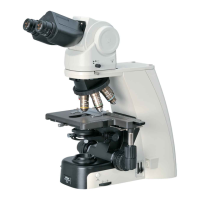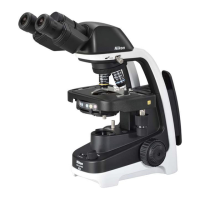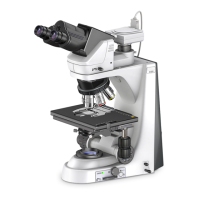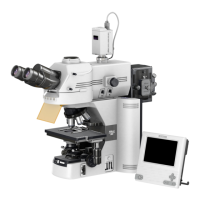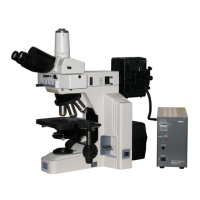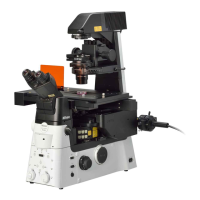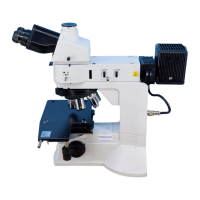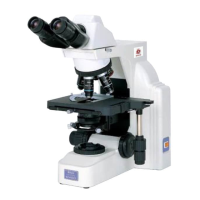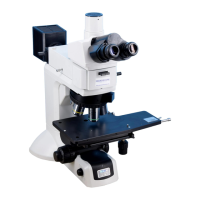Safety Precautions
x
Safety Precautions/Notes on Handling the Product
Notes on Handling the Product
1 Handle with care
This product is a precision optical instrument and
requires gentle handling. Avoid subjecting it to
sudden impacts and shocks.
Even relatively minor impacts are capable of affecting
the precision of the objective.
2 Weak electromagnetic waves
This product emits weak electromagnetic waves. So
as to avoid degrading the performance of precision
electronic devices, do not install this product nea
such devices. If TV or radio reception is affected,
move the TV or radio further from this product.
3 Dirt on the lens
Scratches or fouling optical components (such as
lens and filters) with fingerprints, etc. will degrade
microscope images.
If these parts become dirty, clean them as described
in Chapter 5, “2.1 Lens Cleaning”.
4 Dirt on the lamp (ECLIPSE Ci-S)
Never touch the lamp with bare hands. Dirt o
fingerprints on the lamp will result in uneven
illumination and reduce the service life of the lamp.
Always wear gloves when handling lamps.
5 Installation location
This product is a precision instrument. Usage or
storage of this product in an inappropriate
environment may result in malfunction or a
degradation in precision. Consider the following
factors when selecting an installation location:
● Select a location free of vibration. Install this
product on a level surface.
● Install this product at least 10 cm away from walls.
● Choose a location less exposed to hazards in the
event of collisions, earthquakes, or other potential
disasters. To keep this product from falling, use a
strong rope or other means if necessary to secure
it to the working desk or other heavy, stable item.
● Select a layout that allows easy removal of the
power cord from the product's AC inlet in the event
of an emergency.
● Do not use a desk mat or similar.
● Avoid locations exposed to direct sunlight,
locations immediately under room lights, and othe
bright locations.
● Light from room lights just above this product may
enter the objective as extraneous light. If possible,
switch off the room lights directly above this
product when making observations.
● Select a location with minimal dust.
● To avoid splashes, do not use this product nea
water.
● Make sure the ambient temperature is 0 to +40°C
and humidity is 60% or less. When transporting o
storing this product, the ambient temperature
must be -20 to +60°C, with the humidity at 90%
RH max (with no condensation). Installing this
product in a hot, humid location may result in the
formation of mold or condensation on lenses,
impairing performance or causing malfunctions.
● Do not place this product in a locker or cabinet.
6 Handling of focus knob
● Never turn the focus knobs on the right and left
sides of the microscope in opposite directions at
the same time. Doing so may damage this
product.
● Turning the coarse focus knob past its farthest
point will damage this product. Never use undue
force when turning the knob.
7 Protect the ports from dust and extraneous
light (when the trinocular tube or the
ergonomic tube is attached).
To keep out extraneous light and dust, always attach
the supplied cap to any port not currently in use.
8 Handling of filters (when using the
epi-fluorescence attachment)
● Excitation filters inside a filter cube are exposed
to strong light and degrade over time. Replace
them after the appropriate number of hours.
● Filter characteristics may alter if the filter is
exposed to high humidity. To prevent changes o
degradation of filter characteristics, avoid using o
storing the filters under conditions of high
humidity or high temperature. Avoid subjecting
filters to rapid temperature changes. When a filte
is not in use, store in a desiccator or hermetically
sealed container with a drying agent.
● Especially the filters in the nine types of filte
cubes listed below offer sharp, high-resolution
waveform characteristics superior to normal
filters. However, due to their sophisticated
coatings, they must be handled with special care.
Take care to avoid abrasion from cleaning. Follow
the description in “2.1 Lens Cleaning” in Chapte
5.
Single-band filter cubes:
DAPI, FITC, TxRed, GFP
Multi-band filter cubes:
F-R, F-T, D-F, D-F-R, D-F-T

